Have you ever seen a beautiful variegated pothos and wondered how you would care for such a diverse array of foliage? You’ve arrived at the right place. One of the most valuable features of these variegated plants are their ease of upkeep. They not only grow swiftly, but they also reproduce quickly. In this article, I’ll share with you my tips for variegated pothos care.
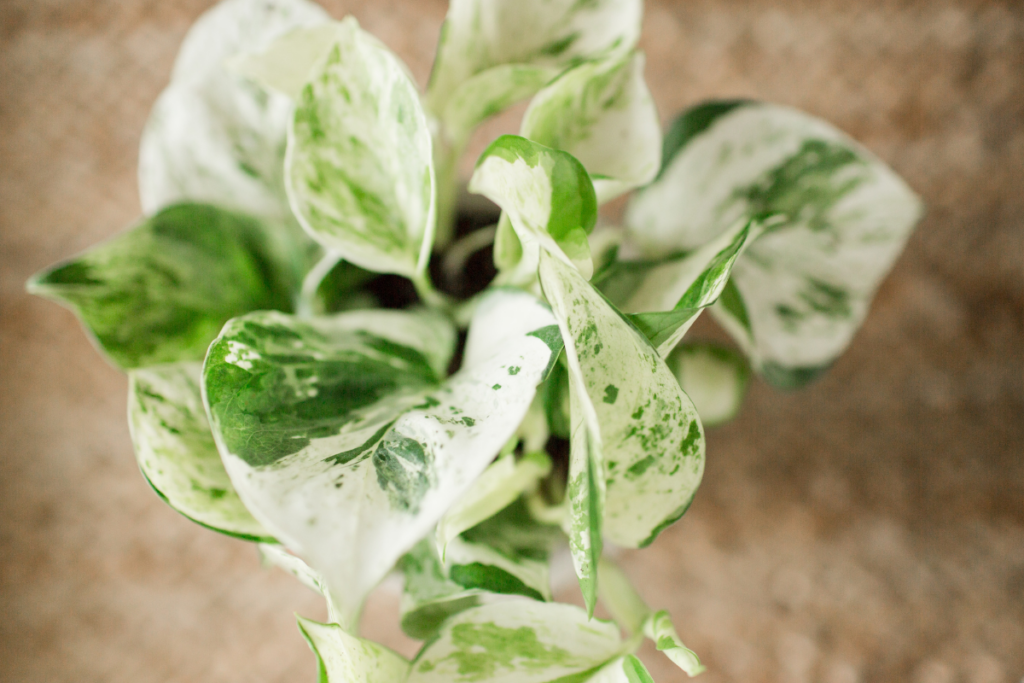
Variegated Pothos are wonderful plants to watch develop since every leaf is different and gorgeous. This is truly a must-have for every collector!
You want to learn more about plants, right? The optimal care for this plant is covered in the sections below.
Profile
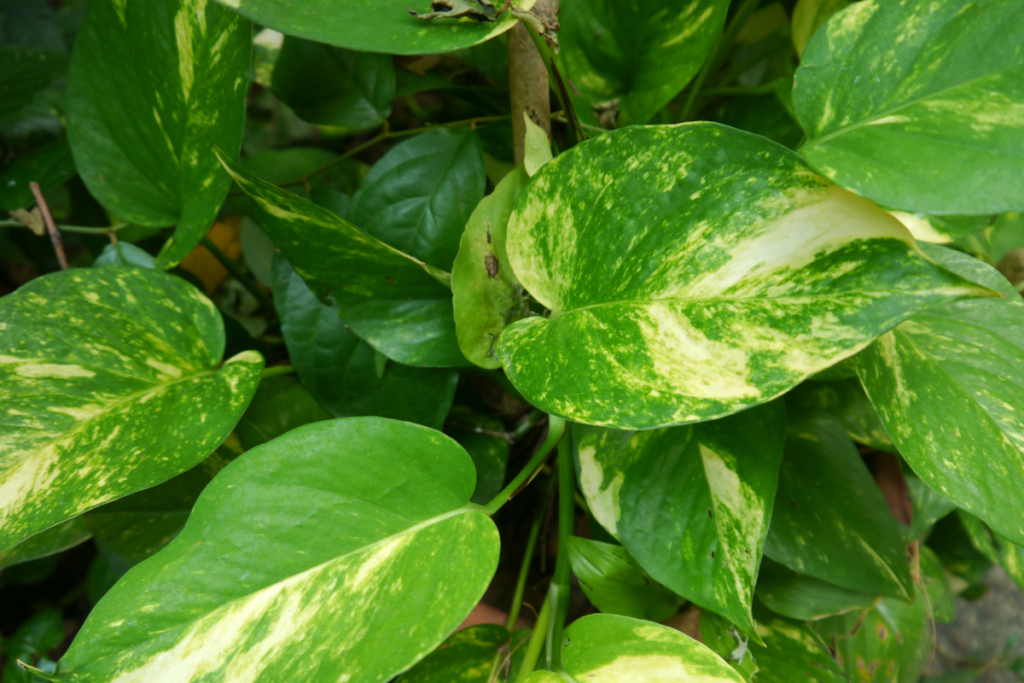
General Information
Variegated Pothos (Epipremnum aureum) is a showy, rare-class perennial evergreen indoor plant of the Arum plant family, Araceae.
This variegated plant, sometimes called devil’s ivy, golden pothos, or hunter’s rove, is one of the most popular home plants in Southeast Asia. A tropical plant that may grow into a bushy houseplant, vine, or terrarium plant.
It has thick, waxy, heart-shaped leaves that are green with yellow splotches. This plant is well-liked for its glossy, bright green, or variegated foliage on cascading down its stems. Its horizontal ground cover only grows six to eight feet tall, but the trailing or climbing vines can reach lengths of 40 feet.
RELATED: Droopy Pothos? No Problem! How to Save Your Drooping Plant
About Variegated Pothos
What Makes Pothos Variegated?
One of the coolest visual characteristics a houseplant can have is variegation. It is also found in the pothos plant. Variegation in most plants is actually a genetic mutation. The distinct color contrasts in variegated Pothos plants, also referred to as chimeral variegation, are caused by the proximity of cells from different genotypes.
This results in areas of various colors, typically bright yellow or creamy white. A variegated Pothos plant requires more sunlight than a regular Pothos plant because the mutations are less effective at photosynthesis. Mutations occur at random after successive generations of propagation.
Pothos Variegation Patterns
Pothos are one of the most popular types of variegated plants since they are easy to care for and come in a variety of colors.
The most popular type of variation is bicolor, where the green foliage is patterned with a lighter color. Spots, patches, stripes, and bicolors in pinks, reds, whites, greens, and cream are among the patterns.
Some cultivars, such as Hawaiian, have more circular spots. Elongated striped patterns that are often present around the centers or edges of the leaves can be indicative of some variegation. Patches are large areas of the leaf that are entirely variegated and can cover the entire leaf or a major portion of it.
Variegated Pothos Varieties
Variegated pothos are amazingly beautiful, and there are many types of them. They come in various shapes and patterns that improve the beauty of any space.
Hawaiian Pothos: The Hawaiian Pothos features large, dark green foliage with yellow spots and flecks. It looks very similar to Golden Pothos, but it has slightly rounded leaf tips.
Manjula Pothos or Satin Pothos: It has remarkable white, light green, silver, and cream streaks. It looks like a Marble Queen, but the heart-shaped leaflets of Manjula pothos have curving borders.
Marble Queen Pothos: is a highly variegated cultivar of the classic Pothos houseplant. It has bright green leaves that are mottled with bright, creamy white variegation. It has split down the middle of the leaf, where one side is green, and the other is variegated.
N’Joy Pothos: One of the most attractive variegated pothos features small leaves with large white patches that are frequently found on the leaf’s outer border.
Pearls and Jade: One of the rare variegated pothos, it is a hybrid between the N’joy and the Marble Queen Pothos. These pothos differ from the majority in that they have white or silver edges.
Snow Queen Pothos: The variegation is a more prominent white color than cream, and it looks very similar to the Marble Queen.
Golden Pothos: The leaves can naturally variegated in color from creamy green to deeper green. They are also known as “Devil’s Ivy” and are easily recognized by their heart-shaped, evergreen leaves with golden wisps and yellow variegation.
Variegated Neon Pothos: These are pothos that have bright lime-green leaves with dark green variegated stripes. New leaves have vibrant colors, and the mature leaves have a deeper neon color. However, not all neons are variegated. Some have foliage that is entirely lemon-lime in color.
Harlequin Pothos: It’s a hybrid between Marble and Snow Queen pothos, and the foliage features solid white and dark green color patterns.
Glacier pothos: A rare variety of pothos species, Its variegation has irregular white streaks on the leaves, giving it the attractiveness of its foliage.
Season Of Interest And Purchasing
The variegated pothos plant’s growth season is from early spring until fall. They may be collected and added to other flower varieties in a vase to enhance their appearance. This attractive ornamental plant may be maintained inside in a container.
If you want an indoor plant that requires little upkeep, pick this one. While also enhancing air quality, it gives the interior design an unusual character. Online or at one of these unique plant shops, you may find variegated pothos.
Growth
Your variegated pothos’ growth rate will depend on its environment and the level of variegation. As less chlorophyll is present in widely variegated types than in other varieties, less photosynthesis takes place, reducing the pace of development.
Under ideal conditions, when it gets mature, some creep may reach 6 to 8 feet, while the trailing, ascending vines can grow up to 40 feet. Some species might develop more slowly. However, providing optimal conditions and care will ensure the quickest growth rate.
RELATED: Pothos Leaves Curling, its Causes and Easy Ways to Fix Leaf Curl
Variegated Pothos Overview
| Scientific name | Epipremnum aureum |
| Common name/s | Variegated Pothos, Devil’s Ivy, Golden Pothos, Hunter’s Rove |
| Family | Araceae |
| Growth Habit | Climbing, Vine, Creeper, Epiphyte |
| Height and Spread | 6-9 feet long and can climb or trail up to 40 feet |
| Classification based on life cycle | Perennial |
| Origin and Distribution | Distributes in SouthEast Asia, China, Taiwan, Malesia, Australia, Pacific Islands |
| Climate Zone | Generally warmer climate |
| USDA Plant Hardiness Zone | USDA Zone 10 – 12 |
| Color | Evergreen with splashes of white and vibrant green foliage depending on the variety |
Care Tips
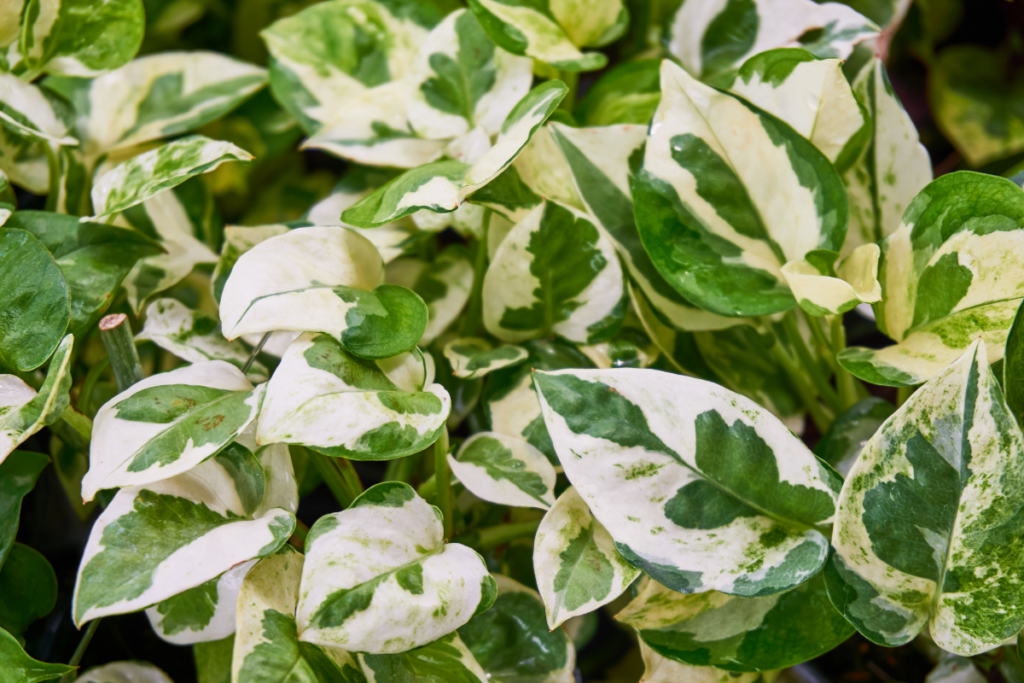
Light Requirement
Variegated pothos prefers bright but indirect light, but they can also survive in low and medium light conditions. Certain types of variegated pothos can handle more sunlight. However, this plant should not be exposed to direct sunlight, since it might cause sunburn and blistering of the leaves.
Temperature Requirement
These lovely variegated plants are mostly found in tropical areas, but they will thrive in a conventional home or office setting, although a warm environment is ideal. Keep the temperature between 60 and 80 degrees Fahrenheit (15 and 26 degrees Celsius).
Maintain a room temperature of at least 60 degrees Fahrenheit. This ensures speedy and optimal development. To avoid stunted development, keep the variegated pothos away from temperatures below 65 degrees Fahrenheit.
Water Requirement
One of the most important components of care is giving variegated pothos the right amount of water. It needs routine watering, but the top soil must dry out before watering again. When watering your pothos, it’s crucial to take proper soil drainage and water balance into account. These plants don’t like to sit in soggy soil, so avoid overwatering.
Humidity Requirement
Humidity level has an impact on the success of producing these variegated pothos. Variegated pothos prefer a humidity range of 50–70%. Making the environment more humid is ideal for growing variegated pothos types of houseplants and preserving their vibrant colors and patterned leaves.
In any case, there are ways to attain this high humidity, such as spraying the leaves once a week, using a plant saucer tray, and using a room humidifier.
Soil Requirement
Give your pothos an organic, well-draining soil mixture if you want it to flourish and for the soil to be rich in essential nutrients. The PH level should be neutral; 6-7 is recommended. A light, loose potting mix made of perlite, orchid mix, and cactus soil can be used to achieve this.
Use a basic, well-draining potting mix to grow variegated pothos. To improve your potting mix’s ability to drain, feel free to add a few handfuls of perlite or coco coir if you have them on hand. Additionally, it needs to have adequate aeration, drainage, and water retention qualities in order to produce a more effective soil mix.
Fertilizer Requirement
Pothos is known to be a light feeder. Therefore, it may only be beneficial to feed them every two weeks up to once a month with a liquid, well-balanced fertilizer.
A balanced fertilizer of NPK 10-10-10 or 5-5-5 is recommended. Dilute it to half strength and apply either monthly or bimonthly to boost its growth during the spring and summer seasons. Reduce fertilization to once a month during autumn and winter.
Space Requirement
Pothos can grow up to 6-9 feet tall. These plants are not particularly picky in planting pots as long as they have enough space to grow and receive the minimum requirements.
Growing And Planting Tips
Propagation
The preferred method for propagating variegated pothos is through stem cuttings. Below are the easy propagation tips for propagating your plant:
- Find a healthy stem with at least four leaves present, and locate its node. The node is the intersection of the leaf with the stem.
- Cut the chosen stem just below the leaf node using clean, sterilized, sharp scissors or shears. Make sure that the node is intact because it is where new roots will form.
- Place the end of the pothos cuttings in nutrient-infused water or wet fresh potting soil until roots develop. Do not let the soil dry out.
- Roots generally take about two weeks to begin forming. You will need to decide when to keep the rooted cutting in water or move the soil.
- If you wish to transfer it to a potting mix, you may see the above soil requirements for reference. Put the pothos cuttings under bright indirect light or partial shade.
- Never let the plant sit under bright light, as too much light will inhibit healthy growth.
Pruning
This plant needs very little maintenance. You only want to prune your pothos plant when it becomes leggy or when you want to keep it at a certain size. To prune your plant, use a clean and sterile cutting shears or scissors to cut a few leaves.
It may also be beneficial to wipe it with neem oil or rubbing alcohol monthly to remove dust and reduce the risk of plant infestations.
Potting And Repotting
It is best to repot your Pothos plant when the plants become rootbound. Just make sure not to damage the root ball as it can be detrimental to the plant. Always use a type of pot that is the right size, with draining holes.
If you are growing your plant in water and you want to transfer it to the soil, it becomes a little more complicated. As your plant’s roots grow, it is harder for them to adapt to a new medium. So if you wish to do this, make sure the roots are still small to transition smoothly.
Variegated Pothos Care
| Light | Bright indirect light |
| Temperature | Intermediate to warm, 60-80 degrees Fahrenheit |
| Water | Once a week, increased in summer, decreased in winter |
| Soil | Fertile, well-draining mix |
| Fertilization | Regular household fertilizer, once a month |
| Space | Minimal space, vertical space needed |
| Propagation | Via stem propagation |
| Blooming | Rarely blooms, enough sunlight and maturity needed |
| Pruning | Little maintenance |
| Potting | Regular potting mix with parts of perlite and peat |
Problems And Troubleshooting
Yellow leaves
Yellowing of your Pothos may be due to several reasons, including:
- Over-exposure to direct sunlight
- Too much fluctuations in the temperature
- Spider mites infestation
- Lack of nutrition due to insufficient fertilizer
- Overwatering
To avoid these problems, make sure to check the plant care tips and guide. It is essential to find the right balance and your plant’s preference. Pay attention to your plant’splant’s signs and symptoms so you can provide its needs accordingly.
Diseases
Root rot is still the most common disease that Pothos plants faces. To avoid this, make sure your soil is well-draining and that the pots have drainage holes. You might also want to check on your watering habits. Your plant may be receiving more water than it should. Overwater makes your pothos njoy wilting.
Pests
The common enemies of pothos plants are household pests such as aphids, plant scales, mealybugs, and whiteflies. They get this when they are exposed to other infested plants.
In order to get rid of them, you can use neem oil, a natural pesticide. Mix 2 teaspoons of neem oil and one teaspoon of liquid dish soap with a quart/liter of lukewarm water. Place in a spray bottle and spray over the peperomia leaves. You may also use 70-percent isopropyl alcohol and apply them directly to the bugs to kill the plant pests.
Curling And Falling Leaves
Curling leaves are usually because of plant pests or, in many cases, nutrient deficiency. To avoid this, check for observable signs of pests like mealybugs and eliminate them when required. If there is a lack of nutrients, you can use a proper and high-quality fertilizer feeding to augment the watering.
For falling leaves, this is usually due to overwatering. Follow the watering tips above, and make sure to only water your plant if the potting mix is dry and cracky at the top.
Why Is My Pothos Losing Variegation
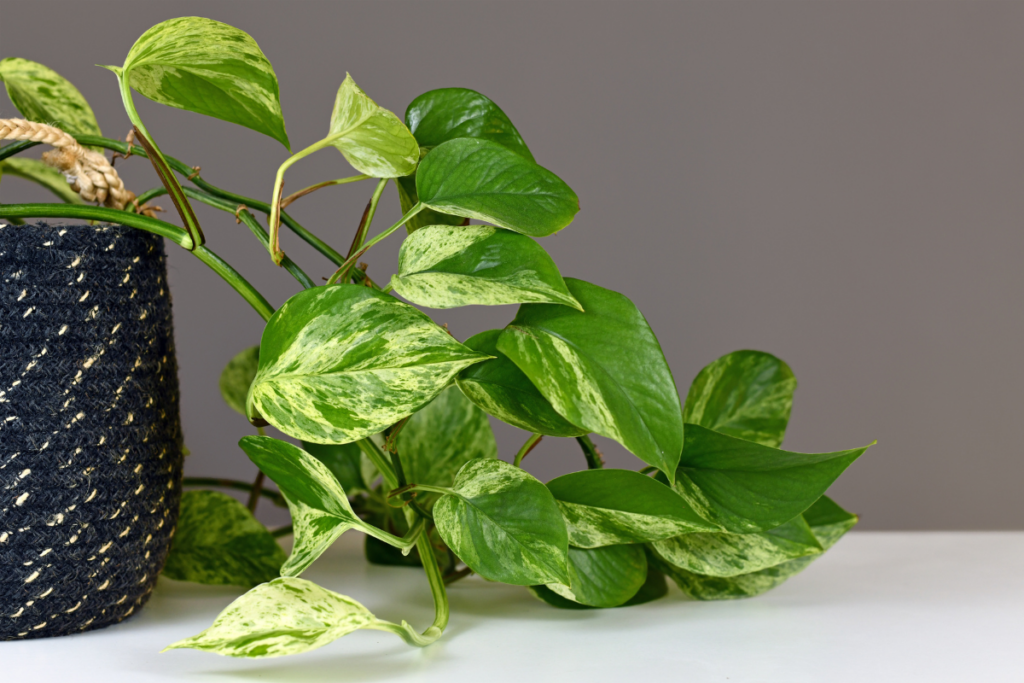
A plant that is variegated lacks the pigment chlorophyll. Chlorophyll, which is abundant in the green portion of leaves, enables plants to absorb sunlight and transform it into energy.
Viruses like the mosaic virus or mutations that influence chlorophyll production are the two main causes of variegation.
It is stated that a variety of factors, including sunlight, seasonality, and more, can contribute to a plant’s loss of variegation.
Your plant will also go to any lengths to try to survive if it is usually unhealthy and merely “hanging on.” This means that in an effort to photosynthesize, it will try to grow additional leaves that are predominantly green.
How To Regain Lost Variegation
Pothos that have variegated leaves can only do so under specific circumstances; otherwise, they can turn their leaves entirely green. Fortunately, maintaining variegation is simple. If the plant begins to turn back to green, there are some simple steps you may do to restore the variegation.
Monitor your plant and move it where it has good temperature and light. Leaving variegated plants in the same location could make maintaining the variegation more difficult because they are sensitive to variations in temperature and light.
- It’s much preferable to have the plant in a portable container that you can pick up and move around. In this manner, there is less competition for the green leaves to dominate, which can encourage your plant to continue generating variegated leaves.
To prevent them from outgrowing the other leaves, prune the non-variegated leaves. Non-variegated leaves might quickly outgrow your plant since they have more chlorophyll than variegated leaves.
- You can cut the leaves with a single color to make sure your plant encourages more with vibrant hues. Additionally, this will cause the plant to produce additional leaves. Soon you will have a plant full of variegated leaves.
Nitrogen is essential for plants, but too much of it can promote chlorophyll growth, making your variegated pothos leaves more on the green side and reducing their overall variegation. If you feed your plant fertilizer, switch to a low-nitrogen formulation.
Various plants require different amounts of nitrogen. Before switching fertilizers, always make sure you are using the right amount for your plant type.
The ideal option is to use a high-quality potting mix and a balanced liquid fertilizer, diluted to half its strength. If the plant exhibits encouraging growth, avoid feeding it too much.
RELATED: Why Are The Leaves Turning Yellow? 8 Reasons Why Your Pothos Is Changing Color
Problems With People And Animals
Toxicity
Pothos have a compound called calcium oxalate crystals within all of its parts. This is considered toxic to both humans and pests. In addition, this may cause skin irritation in some individuals, so make sure to wear gloves if you are handling this plant and if you suspect you might have a reaction.
Pothos Plants Meaning And Symbolism
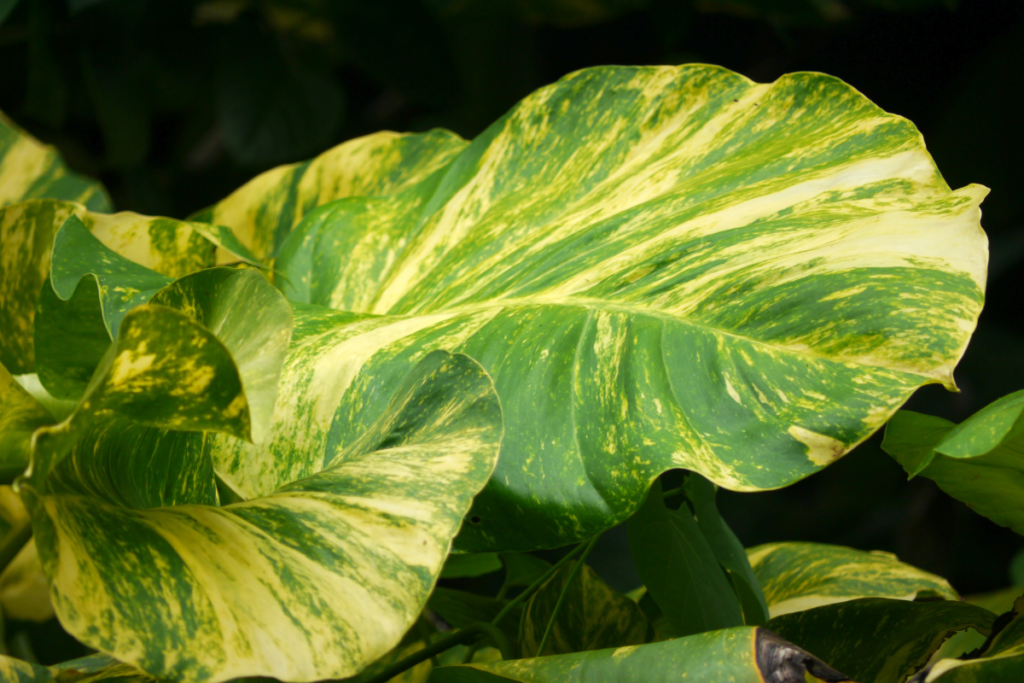
Pothos plants are known to represent perseverance. Their vines grow long and fast with determination, especially if they are arranged in hanging pots or in poles reaching new heights. This is perfect for people who are always relentlessly following their dreams.
| General Meaning | Perseverance and determination |
| Symbolism | Relentless following of dreams |
Landscaping And Gardening Ideas
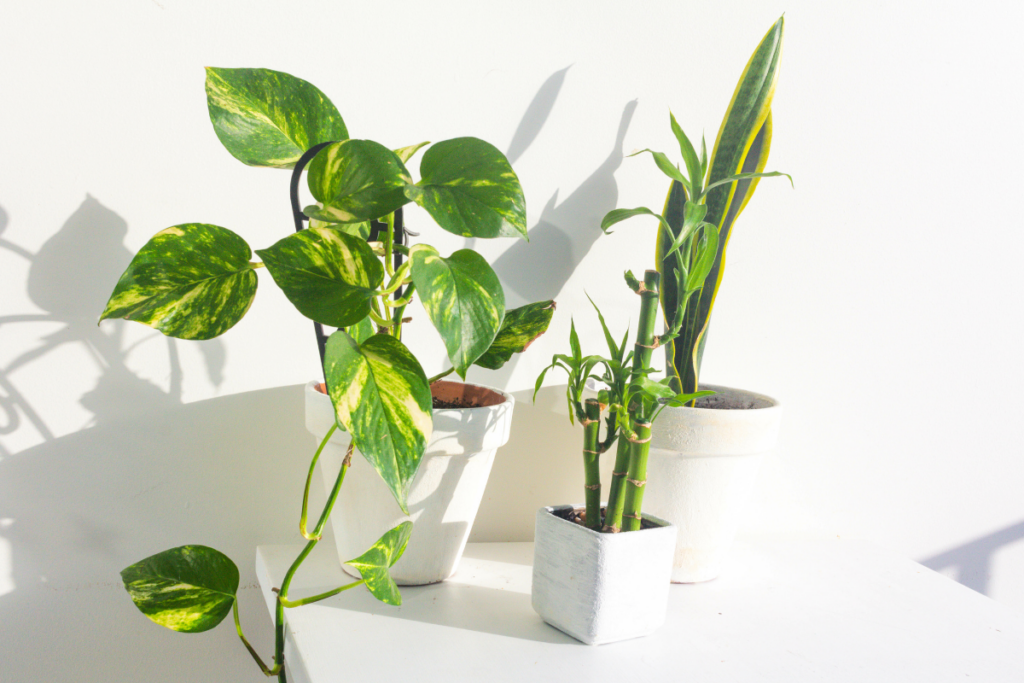
Companion Plants
The pothos plants go well with other tropical plants, specifically aroids, and philodendrons. They can also stand out on their own!
Landscaping Ideas
Pothos NJoy plants are well enjoyed in the interior of homes and offices. It can be placed on a lonely desk or let it sprawl on the top of your kitchen cabinets. Alternatively, they can be grown in hanging baskets or with moss poles. Whatever way, they are always a delight to look at.
| What to plant with | Other Aroids, Peperomias, Philodendrons, and other tropical plants |
| What NOT to plant with | Basically nothing |
Final Thoughts
Variegated pothos are an excellent choice for a houseplant because of their stunning appearance and attractive ornamental foliage. These wonderful varieties are full of personality and simple enough for beginners to take care of.
Consider acquiring this houseplant for display; it will give any collection of houseplants a playful twist. Variegated pothos is also a great indoor plant for air purification, which eliminates typical pollutants. A variegated pothos plant is believed to be lucky and bring wealth and fortune to its owner.
Editor’s Recommendations
Snow Queen Vs. Marble Pothos: Similarities and Differences
How To Propagate Pothos: Thing To Consider
Pothos Vs. Philodendron: How To Tell Between The Two Popular Houseplants?







